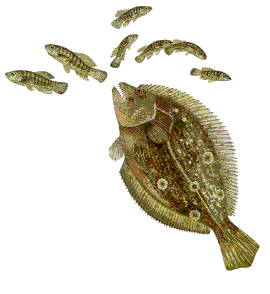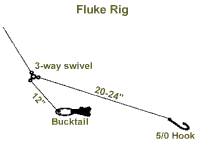Like most things, fishing is more enjoyable with company. I most often fish with one or more of a small group of friends, but my favorite partner is my daughter Beth. I first started taking her fishing in lakes and calm tidal rivers when she was about five. By the time she was fourteen, she had completed a safe  boating course and was able to take her turn piloting our 21-foot center console fishing boat in the coastal bays and rivers near our home. We fish for all of the inshore species from time to time, but our most frequent target is summer flounder, better known as fluke.
boating course and was able to take her turn piloting our 21-foot center console fishing boat in the coastal bays and rivers near our home. We fish for all of the inshore species from time to time, but our most frequent target is summer flounder, better known as fluke.
There are a number of reasons why fluke remain our favorite target when other species such as striped bass get so much larger and species like bluefish fight so much harder. First of all, they are available in New Jersey's bays and inshore ocean waters for a long season, typically from May through October. They continue to be abundant in the heart of the summer when some other species tend to stay in deeper, cooler ocean waters or migrate northward. Unlike many fishes which are active primarily in the lower light conditions of morning and evening, fluke are readily taken all day long. Add to all this the fact that fluke are great to eat, and you can see why we like to fish for fluke.
We fish almost exclusively from our boat, but because of their extensive inshore distributions, fluke can be caught from rental boats, party boats or while fishing from shore. A typical fishing outfit would include a five to six foot rod with either a conventional or spinning reel filled with 10 to 20 pound test line. I prefer a conventional  reel for fluke because it is easy to let the line out gently. My daughter prefers spinning tackle, possibly because she learned to fish with a spinning outfit and handles it well.
reel for fluke because it is easy to let the line out gently. My daughter prefers spinning tackle, possibly because she learned to fish with a spinning outfit and handles it well.
One tip to anyone fishing with a child or any first-time angler: make sure they have a smoothly operating fishing rod and reel, even if you have to give them your favorite outfit. Nothing can frustrate a new angler as much as an outfit they can't operate. As an experienced angler, you are much better equipped to deal with the idiosyncrasies of an older rod and reel. If a child, or an adult for that matter, does not enjoy his or her first fishing experience, chances are that it will also be their last.
Summer flounder lie on the bottom, partly concealed with sand and partly by its coloration, which can be changed to blend in with the surrounding environment. When suitable prey appears, it rushes out and devours the victim. This "ambush" feeding strategy probably explains why fluke activity is not restricted to only morning or evening low light conditions. The best fishing strategy to take advantage of this behavior is to fish very near the bottom with a moving bait. Due to their large mouth and aggressive nature, large hooks (4/0-6/0) work well and reduce the chance that smaller, sub-legal fish may swallow the hook and be damaged or killed. I like to use a two hook rig.  I start with a three way swivel on the end of my line and attach a 10 to 12 inch leader from the swivel to a bucktail tipped with bait such as a strip of squid or clam. The bucktail serves as a weight to keep the rig near the bottom as well as a baited hook. To the third eye of the swivel I attach a longer leader, approximately 18 to 24 inches in length, to an unweighted hook adorned with a feather or mylar streamer and another bait, usually a live killie. This bait stays off the bottom, yet is within easy reach of the aggressive fluke. I like to start fishing with a different type of bait on each of the two hooks. If I notice that one type of bait is catching more fish than the other, I put the bait that is working best on both hooks. When using a live killie, hooked through the lips, it is best to gently drop the bait to the bottom. Casting the bait can dislodge the killie. A gentle drop can be accomplished with either a conventional or spinning reel.
I start with a three way swivel on the end of my line and attach a 10 to 12 inch leader from the swivel to a bucktail tipped with bait such as a strip of squid or clam. The bucktail serves as a weight to keep the rig near the bottom as well as a baited hook. To the third eye of the swivel I attach a longer leader, approximately 18 to 24 inches in length, to an unweighted hook adorned with a feather or mylar streamer and another bait, usually a live killie. This bait stays off the bottom, yet is within easy reach of the aggressive fluke. I like to start fishing with a different type of bait on each of the two hooks. If I notice that one type of bait is catching more fish than the other, I put the bait that is working best on both hooks. When using a live killie, hooked through the lips, it is best to gently drop the bait to the bottom. Casting the bait can dislodge the killie. A gentle drop can be accomplished with either a conventional or spinning reel.
I try to align the boat sideways to a breeze and drift so the bucktail bait just touches bottom occasionally. If the bucktail is too heavy and drags along the bottom, it is more likely to get fouled with debris or be eaten by crabs. I often change the size of my bucktail depending upon the depth of the water and speed of the drift to maintain the proper contact with the bottom. This type of drift fishing covers a lot of ground, is very relaxing and lets you converse with and enjoy the company of your fishing buddy(ies). Beth is in college now, so our fishing time is limited to summer vacations, but we still look forward to and enjoy our quality time together, fishing our local waters.